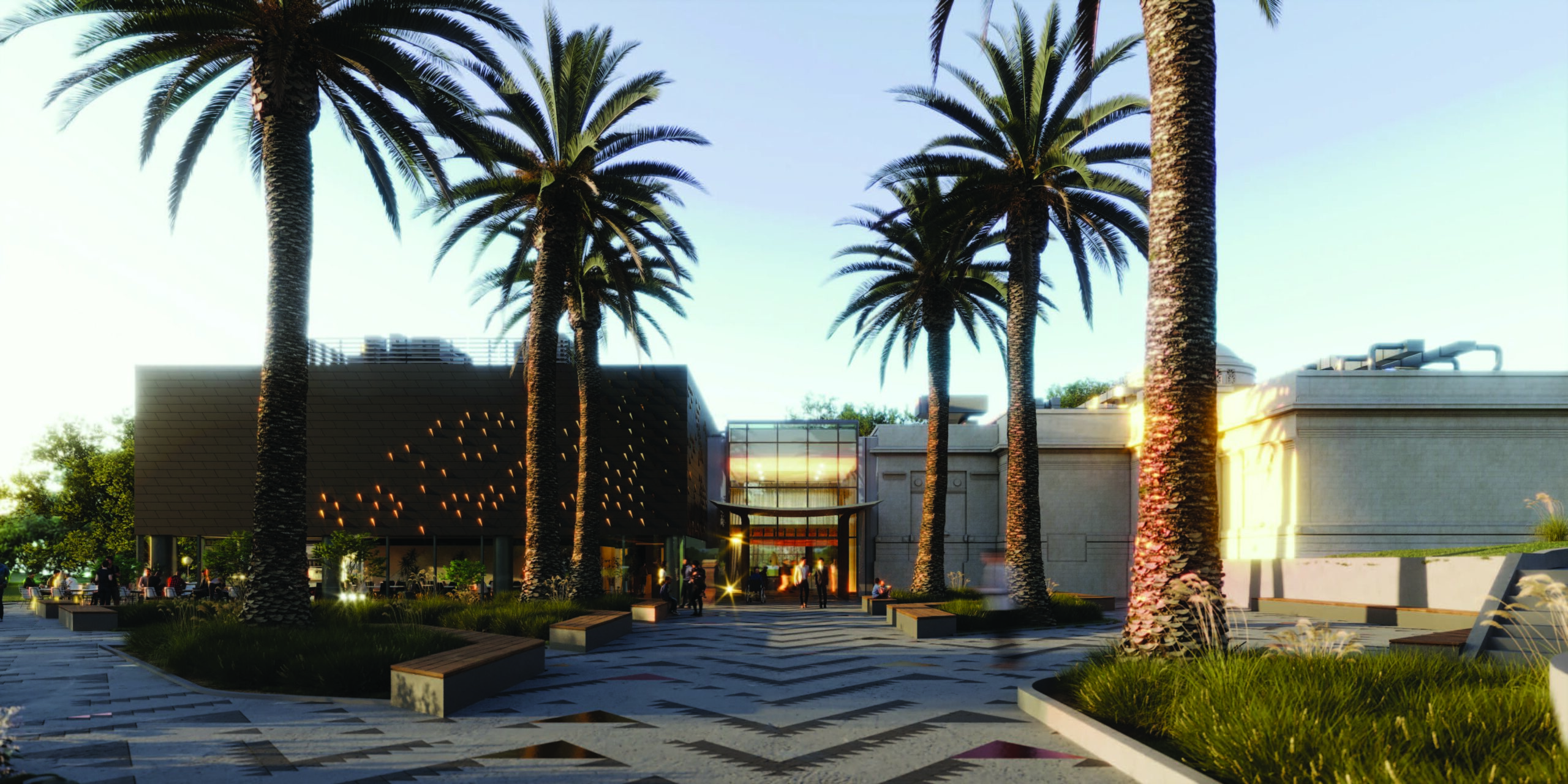About the redevelopment
What is the Sarjeant Gallery Te Whare o Rehua Redevelopment Project?
The Redevelopment will see the construction of a new wing to the north (the rear face) of the existing gallery, honouring the memory of Sir Te Atawhai Archie John Taiaroa. This space will be named Pātaka o Sir Te Atawhai Archie John Taiaroa. It will incorporate storage space for the Sarjeant’s nationally significant collection, as well as education facilities, exhibition spaces, spaces for functions, events and retail, and a cafe.
The original gallery, which has a Historic Places Trust Category 1 rating, is being earthquake strengthened and restored, and will retain its historic architectural features.
Why is the Redevelopment necessary?
In 2014 the Sarjeant Gallery on Pukenamu Queen’s Park was closed to the public and all operations and the Collection moved to the temporary gallery and storage space Sarjeant on the Quay at 38 Taupō Quay.
At that time the Sarjeant Gallery met just 5% of the current new building code and was assessed as being a safety risk to staff and visitors. The storage area was also inappropriate to store the nationally significant collection.
The redevelopment project ensures the preservation and seismic strengthening of a heritage listed, nationally iconic Whanganui building that is one of New Zealand’s oldest purpose built galleries. It also ensures the Sarjeant Collection is properly housed, protected and made accessible to the public.
Why is the Sarjeant Gallery Collection so special?
For over one hundred years, the Sarjeant Gallery Te Whare o Rehua Whanganui, on behalf of the people of our city, has been building its collection of fine art and applied art objects.
With a collection now numbering over 8,300 pieces, in all media, it is unrivalled in regional New Zealand and can be viewed in similar terms to the major municipal collections of Auckland, Wellington, Christchurch and Dunedin. The Sarjeant Collection is nationally significant due to its size and depth of content.
The Sarjeant Gallery itself is one of the finest purpose-built art galleries in the country and the building and collection are inextricably linked and are a part of our national history.
What is the timeframe for the Sarjeant Gallery Te Whare o Rehua Redevelopment Project?
The Sarjeant Gallery Redevelopment Project construction phase commenced in the last quarter of 2019 with asbestos removal inside the existing building.
The redevelopment includes strengthening and restoration of the heritage building and the construction of the new wing. The redevelopment construction phase is scheduled to be completed in early 2024 and the gallery will reopen in mid 2024. The exact reopening date is yet to be confirmed.
The project has suffered some delays, what are the reasons for those?
Delays have for the most part, been related to challenges presented in strengthening of the heritage gallery with existing foundation depths not as expected and strengthening works needing to be programmed sequentially (rather than concurrently) to protect the fragile foundations and old masonry walls. Ground conditions also informed the design of a retaining structure, which delayed excavation work for the new extension building.
The project team has also had to work around the pandemic, and has had to manage the resultant staff shortages, closure of the site and construction material shortages due to supply line disruptions.
As at July 1 2024, two sub-contractors have gone into liquidation during the course of the redevelopment project and the loss of these businesses is very unfortunate for all involved. The principal contractor has worked with the project team to resolve the issue of these two liquidations and suitable alternatives have been secured for the project.
How much will it cost?
As at July 2022 the forecast total project cost is $64.4M including contingency.
How will it be paid for?
The principle project partner is Central Government via funding grants from the Provincial Growth Fund and the Ministry for Culture and Heritage. Other capital partners are the NZ Lottery Grants Board, NZ Community Trust, Stout Trust, Four Regions, Whanganui Community Foundation and the Whanganui District Council; as well as public and private trusts and a multitude of individual donations both large and small.
Where additional funding is required, the Sarjeant Gallery Trust Board undertakes to fundraise for the outstanding amount.
As the Whanganui District Council has undertaken to underwrite the project, there is no risk of the project stalling due to lack of funds.
What about running costs?
As the Sarjeant Gallery is a cultural facility of the Whanganui District Council, running costs (or operating expenses) are accounted for in the Council’s 10 Year Plan.
Enhanced retail, event spaces, a cafe and other revenue generating opportunities in the redeveloped gallery will help to offset running costs, which are expected to rise due to the increased size of the facility.
Who will pay for expenses outside of running costs?
In late 2019 the Sarjeant Gallery Trust Board established the Sarjeant Gallery Endowment Fund which will:
- Support the acquisition of works
- Help create major exhibitions
- Ensure collection conservation work is possible
- Help the gallery secure national and international touring shows
- Produce education courses and opportunities
- Support partnerships, and knowledge and expertise sharing
Is iwi involved with the Gallery redevelopment?
Yes. Whanganui iwi are key partners in the redevelopment and have had, and continue to have input into the redevelopment and the Pukenamu site.
In July 2020, once the site had been blessed, Mauri stones were buried on site by Te Rūnanga o Tūpoho as Mana Whenua. Tūpoho observers then took part in the archaeological dig during which two cultural items were recovered.
Warren and Mahoney’s architectural design for the new wing has been acknowledged as fit for tikanga and a ringatoi group from the Whanganui region will work alongside architects and engineers to finalise design elements on the new wing.
The new wing will be named the Pataka o Sir Te Atawhai Archie John Taiaroa in honour of the late Sir Archie Taiaroa, rangatira of Whanganui and a highly regarded leader amongst Māori and Pakeha. The meaning of the word Pātaka is that of a “house of storage”, a place where valuable things are safeguarded.
Te Whare o Rehua Whanganui will contain the old and the new, the Sarjeant Gallery and the Pataka o Sir Te Atawhai Archie John Taiaroa.
Who are the architects for the Sarjeant Gallery Development?
Warren and Mahoney, one of New Zealand’s leading architectural practices. Visit www.warrenandmahoney.com for more information.
How were the architects chosen?
In 1996, the Sarjeant Gallery Trust Board supported by the Whanganui District Council undertook an Architectural Design Competition funded by a grant from the Edith Collier Trust.
Council approved the design competition and in June 1998 a Cultural Heritage Assessment was undertaken on the gallery which formed part of the Architectural Design Competition Brief which was completed in August 1998, after which the competition was launched.
The winning design by Steve McCracken of Warren and Mahoney was announced a year later in August 1999 and then made subject to public consultation and review by stakeholder groups.
Has New Zealand Historic Places Trust been involved in the process?
Heritage New Zealand (formerly the NZHPT) recognises the importance of the Sarjeant Gallery building, the part it plays in New Zealand’s and Whanganui’s cultural history and the need to ensure its longevity.
They have expressed their support and agreement with the proposed redevelopment in a letter, which accompanied the application to the Regional Museums Fund, and have renewed their support for the developed design plans both in letters to Central Government and in support of the Resource Consent application.
A Memorandum of Understanding has been agreed between Whanganui District Council, Te Rūnanga o Tupoho on behalf of Te Awa Tupua and the New Zealand Historic Places Trust to oversee and to advise on developments impacting on the Category 1 Sarjeant Gallery building.
What is being done to seismically strengthen the original part of the gallery?
The ‘post-tension strand’ methodology has been selected as the best option for the Sarjeant Gallery.
This involves long steel strands inserted vertically into the gallery’s exterior walls forming a cage like protection structure, which works in conjunction with basement strengthening works and a new diaphragm ring beam at roof level.
How has Whanganui District Council supported the project?
Whanganui District Council has:
- Launched the fundraising leg of the project
- Moved the project to the ‘developed design stage’ at a cost of up to $1 million (completed in June 2014)
- Gained resource consent for the full redevelopment project including strengthening of the existing gallery and construction of an adjoining wing which will house new facilities and environmentally controlled storage (completed in August 2014)
- Supported the temporary relocation of the gallery (completed in May 2014 for the operation, public programmes, education service and December 2015 for the collection) to 38 Taupō Quay while fundraising and subsequent construction of the redevelopment is undertaken
- Allocated a total of $5M towards the Sarjeant Gallery Redevelopment Project. This is inclusive of $4 million from its Earthquake Strengthening Rate, noted in the current 10 Year Plan
- Engaged a Sarjeant Gallery Redevelopment Project Director in November 2018 (Gaye Batty)
Why did the Gallery move to Taupō Quay?
In order to mitigate the risk to the public, staff and collections due to the earthquake risk posed by the original gallery and pending the redevelopment, Council decided on 20 December 2012 to temporarily relocate the gallery and its collection to an interim location. This interim location was located at 38 Taupō Quay and is called Sarjeant on the Quay.
The relocation was necessary due to the earthquake prone status of the Sarjeant Gallery posing a safety risk to staff and the public and the risk of damage to the collections.
How long did the relocation take?
Relocating the gallery operations took 4 months and moving the Sarjeant Collection took 21 months.
The Sarjeant Gallery on Pukenamu Queen’s Park was closed to the public on 2 March 2014.
Building work at the temporary gallery was completed in April 2014.
Sarjeant on the Quay, 38 Taupō Quay opened on 24 May 2014.
At the same time, the collection totalling more than 8300 items was relocated to the first floor of 38 Taupō Quay – this was completed in December 2015. The transition project included full documentation and condition reporting of the collections, making possible the launch of the digital collection portal ‘Explore the Collection’ in 2017.
What did the relocation cost?
The total project cost was $2,678,000 over five years. This included the rent of the interim location, the move of the collection and the purchase of storage equipment which will be re-used in the redeveloped gallery.
The gallery was awarded a grant of $472,680 by the Lottery World War One Commemorations, Environment and Heritage Committee towards the costs of the store fit-out and temporary staff to expedite the collection move.
Will Sarjeant on the Quay stay open once the Sarjeant Gallery reopens at Pukenamu?
No, Sarjeant on the Quay will permanently close prior to the redeveloped Sarjeant Gallery reopening.
The collection will be moved from Sarjeant on the Quay to the purpose built, environmentally controlled collection store under the Pataka o Sir Te Atawhai Archie John Taiaroa. This process is expected to be complete by December 2024 and will commence after the gallery is settled, tested and reopened.
Once the redeveloped gallery is opened all exhibitions, events, education programmes and staff operations will all be ongoing at the Sarjeant Gallery on Pukenamu.
Will there be an entry fee when the new gallery opens?
No. It is important to Whanganui District Council and gallery management that the Sarjeant be accessible to all sectors of the community and that the gallery be at the heart of the community. Donations will always be gratefully accepted and will go towards the Sarjeant Gallery Endowment Fund.




